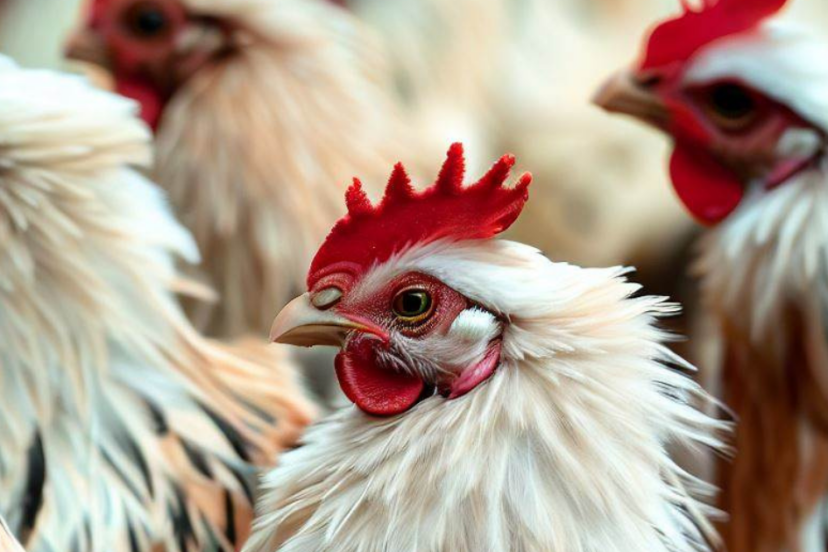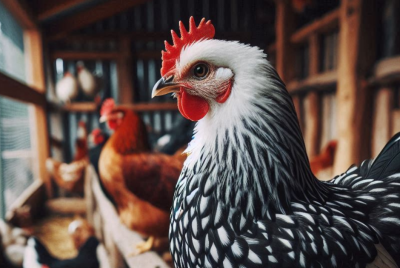Introduction to Buff Laced Polish Chickens
Buff Laced Polish chickens are a delightful and captivating breed known for their unique appearance and friendly personalities. With their distinct feathering and lively disposition, these charming birds have become a favorite among poultry enthusiasts. In this comprehensive guide, we will explore everything you need to know about raising and enjoying Buff Laced Polish chickens.
Characteristics and Appearance of Buff Laced Polish Chickens
Buff Laced Polish chickens have a tuft of feathers on their heads, forming a crest that adds to their unique charm.
While Polish chickens and Silkies share some similarities in terms of their appearance and characteristics, they have a few distinct differences:
1. Crested Head: Both Polish chickens and Silkies have a crest of feathers on top of their heads. The crest is more prominent in Polish chickens, forming a large, fluffy tuft, while Silkies have a smaller, rounder crest.
2. Feathered Feet: Both breeds have feathered feet and legs. The feathers on their feet extend down to their toes, giving them a distinctive appearance.
3. Soft Plumage: Polish chickens and Silkies have soft, fluffy plumage that lacks the hard and glossy feathers found in many other chicken breeds. Their feathers have a silk-like texture, which is particularly pronounced in Silkies.
4. Broodiness: Both Polish chickens and Silkies are known to be broody, meaning they have a tendency to go broody and exhibit strong maternal instincts. This can make them good candidates for hatching and raising chicks.
5. Gentle Dispositions: Both breeds are generally known for their calm and friendly dispositions. They are often regarded as docile and easy to handle, which can make them suitable for families or individuals seeking a pet-like chicken.
While Polish chickens and Silkies share these similarities, it’s important to note that they are distinct breeds with their own unique characteristics. Polish chickens are known for their larger size, elongated bodies, and varied color patterns, while Silkies have a small, round body shape, five toes, and distinct black skin. Both breeds are popular for their ornamental value and make delightful additions to any backyard flock.
Selecting and Acquiring Buff Laced Polish Chickens
When choosing Buff Laced Polish chickens, it’s essential to select healthy and well-bred birds. Look for reputable breeders or hatcheries that prioritize breeding for both appearance and temperament. Inspect the birds for alertness, clean feathers, and bright eyes. It’s also important to consider the breed standard to ensure you’re getting Buff Laced Polish chickens that meet the desired characteristics.
Housing and Coop Requirements for Buff Laced Polish Chickens
They require appropriate housing and a secure coop to thrive. Provide a spacious and well-ventilated coop with the right windows that protects them from predators and extreme weather conditions. The coop should have perches, nesting boxes, and ample space for them to move around comfortably. Ensure the coop is kept clean to prevent health issues and maintain the overall well-being of your flock.
Feeding and Nutritional Needs of Buff Laced Polish Chickens
A
balanced and nutritious diet is vital for the health and productivity. Offer a high-quality poultry feed specifically formulated for laying hens. Additionally, provide access to fresh water at all times. Supplement their diet with kitchen scraps, vegetables, fruits, and occasional treats like mealworms. Monitor their weight and adjust their feed accordingly to prevent obesity or malnourishment.
Health and Care Tips for Buff Laced Polish Chickens
Maintaining good health is crucial. Regularly inspect your flock for signs of illness or injury. Keep their coop clean, as a clean environment helps prevent the spread of diseases. Provide proper veterinary care and vaccinations when necessary. Additionally, ensure they have access to dust bathing areas to help them keep their feathers clean and free from parasites.
Breeding and Reproduction of Buff Laced Polish Chickens
They can be a rewarding endeavor. Make sure to have a separate breeding pen to isolate the breeding pairs. By monitoring and collecting the nesting boxes for eggs regularly, will ensure the nesting position is optimal. They are known for their broodiness, so consider providing a safe and comfortable space if you want them to hatch their own eggs.
Egg Production and Egg Quality of Buff Laced Polish Chickens
They are decent layers, providing a moderate number of eggs throughout the year. On average, they can lay around 150 to 200 medium-sized eggs annually. The eggshell color is typically white or cream. Although not the most prolific layers, they make up for it with their unique appearance and endearing personalities.
Training and Socialization of Buff Laced Polish Chickens
They are naturally curious and social birds. Spend time with them, interact, and handle them gently from an early age to ensure they are comfortable with human contact. They can be trained to come when called and may even enjoy supervised free-ranging sessions in a secure area.
Socializing
They thrive in social environments and enjoy the company of their flockmates. Introduce new chickens gradually, allowing them time to establish a pecking order and bond with the existing members. Encourage positive interactions by providing perches, roosts, and enrichment activities within the coop. Regularly observe their behavior to ensure harmonious relationships among the flock.
Conclusion
Buff Laced Polish chickens are a delightful addition to any poultry enthusiast’s flock. With their captivating appearance, friendly demeanor, and moderate egg production, they offer both aesthetic appeal and companionship. By providing proper care, housing, nutrition, and socialization, you can enjoy the unique beauty and charm of Buff Laced Polish chickens in your backyard.
FAQs
1. Do they require special grooming for their crests?
They do have crests that require regular maintenance. Trim the feathers around their eyes to ensure clear vision and prevent feather blindness. Additionally, gently clean their crests to remove dirt and debris.
2. Are they good for families with children?
Yes, They are generally docile and can be a great addition to families with children. However, as with any pet, supervision and gentle handling are important to ensure the well-being of both the chickens and the children.
3. Can they tolerate cold climates?
They are relatively hardy but may require additional protection in extremely cold climates. Ensure their coop is well-insulated, provide extra bedding, and consider using heat lamps during freezing temperatures.
4. Are they prone to health issues?
While they are generally healthy, their crests can make them more susceptible to eye and feather-related problems. Regular monitoring, proper nutrition, and maintaining a clean coop can help prevent potential health issues.
5. Do they require special fencing to prevent them from flying over?
They are not known for their flying abilities and are usually content staying close to the ground. A standard poultry fence or netting should be sufficient to keep them contained in the designated area.
*We may earn a commission from purchases made through our links, at no cost to you. This does not affect our product recommendations. Please see our disclosure to learn more.




